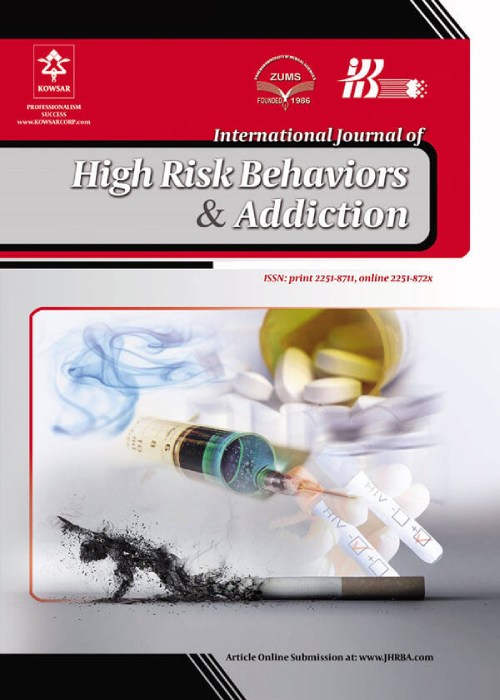فهرست مطالب

International Journal of High Risk Behaviors and Addiction
Volume:11 Issue: 4, Dec 2022
- تاریخ انتشار: 1401/11/30
- تعداد عناوین: 7
-
-
Page 1Background
Seizure is one of the most severe side effects of tramadol abuse that can be irreversible.
ObjectivesThis study aimed to investigate the frequency of tramadol abuse-associated seizure and electroencephalogram findings in patients with seizures.
Patients and MethodsThis cross-sectional study was conducted on patients with generalized tonic-clonic seizures caused by tramadol abuse. After history examination and systemic and neurologic evaluation, patients with abnormality in the neurological examination, metabolic evaluation, or non-contrast CT scan were excluded. Electroencephalography was performed between the third and fifth day. Demographic data and electroencephalographic findings were recorded and analyzed.
ResultsA total of 356 patients with seizures was enrolled, and tramadol abuse-associated seizure was the initial diagnosis in 12.9% of the patients. Among them, 9.3% had tramadol abuse seizures, which followed the study protocol completely. Abnormal electroencephalography was found in 48.5% of the patients, and epileptic discharges were observed in 21.2% of them. The consumed amount of tramadol, the duration of consumption, and the time interval between the consumption of tramadol and the onset of seizure were associated with electroencephalogram abnormality.
ConclusionsTramadol abuse-associated seizures occurred in a significant number of patients. Half of the patients had electroencephalogram abnormalities.
Keywords: Tramadol 1A, Seizure, Electroencephalogram -
Page 2Background
Methadone or buprenorphine maintenance therapy is an effective treatment for opioid dependence. Since the satisfaction of patients under methadone maintenance treatment (MMT) plays an important role in their therapeutic success, it seems important to evaluate the satisfaction of methadone usage using multidimensional psychometric tools.
ObjectivesThe current study aimed to investigate the psychometric properties of the Persian version of the Treatment Satisfaction Questionnaire for Medication (TSQM) version II.
Patients and MethodsThis cross‑sectional study was carried out on 288 opioid-dependent patients of Shahid Beheshti MMT clinic in Kerman, Iran, selected using the convenience sampling method. The data were collected using a questionnaire containing the demographic characteristics of the participants and the Persian version of the TSQM version II containing 11 items in four subscales of effectiveness, side effects, convenience of use, and overall satisfaction. The sum of the scores of each subscale is displayed as a number from 0 to 100. The face and content validity of the questionnaire was confirmed. The construct validity was assessed using exploratory factor analysis (EFA) and confirmatory factor analysis (CFA). The internal consistency and repeatability of the TSQM version II were determined using Cronbach’s alpha and test-retest methods, respectively. LISREL software (version 8.8) and SPSS software (version 20.0) were used to analyze the data.
ResultsThe sample with the male majority of 85% had a mean age of 46.24 ± 11.5 years. As a measure of internal consistency, Cronbach’s alpha of the Persian version of the TSQM version II was 0.8. The repeatability of the questionnaire using the test-retest method was calculated at 0.9. The EFA revealed the adequacy of sampling and justifiability of the analysis (Kaiser‑Meyer‑Olkin = 0.82, P = 0.001, χ2 = 1507.02, df = 28). In CFA, the goodness of fit was at an appropriate level.
ConclusionsThe TSQM Persian version can be used as an effective and consistent tool to assess treatment satisfaction in clinical settings.
Keywords: Patient Satisfaction, Survey Methods, Psychometrics Reproducibility of Result, Islamic Republic of Iran -
Page 3Background
Nonsuicidal self-injury (NSSI) is the direct and deliberate destruction of one’s own body tissue without suicidal intent. This prevalent behavior can have physical, psychological, and social consequences.
ObjectivesThis study aimed to explain NSSI in adolescents based on Hooley’s negative self-association model.
Materials and MethodsThe sample consisted of 223 high school students in public schools in Tehran province, of whom 63 were self-injured and 160 were non-self-injured. The subjects were selected by purposive sampling. The data were gathered using the Deliberate Self-harm Inventory (DSHI), Forms of Self-criticism/Attacking and Self-reassuring Scale (FSCRS), Emotional Avoidance Strategy Inventory for Adolescents (EASI-A), Self-punishment Scale (SPS), Self-injury Implicit Association Test (SI-IAT), and General Health Questionnaire (GHQ). Data analysis was performed based on structural equation modeling (SEM) using the statistical software IBM SPSS AMOS v22.0.
ResultsThe SEM indicated that among the goodness of fit indices, CFI, TLI, and RMSEA were in the desired range. Negative self-association played a central role in NSSI attempts. There was a significant relationship (P < 0.05) between self-punishment and self-injury. Negative associations made people more inclined to avoid negative emotions, but no significant relationship was found with NSSI. However, the path of negative self-association and its relationship with accessibility to and identification with self-injury and attempt to NSSI did not have enough significance and led to a decrease in the model’s fit.
ConclusionsConsistent with the findings of research conducted in the field of self-injury, this study showed that negative self-associations play a central role in attempting NSSI. The results of this study provide a new guideline for designing prevention and treatment programs for self-injuring behavior.
Keywords: Nonsuicidal Self-injury (NSSI), Self-criticism, Emotion, Adolescent -
Page 4Background
In addition to its potentially harmful physical consequences, coronavirus disease 2019 (COVID-19) can cause various negative psychological consequences for individuals. One cohort likely to have been affected is university students who have had to return and study from their home cities due to the physical closures of universities.
ObjectivesThe present study was conducted on students to assess psychological impacts (i.e., anxiety, depression, and stress) in predicting COVID-19 anxiety resulting from returning home and quarantining due to university closure.
Materials and MethodsThe study sample comprised 715 Iranian students who were asked to complete the Depression, Anxiety, and Stress Scale-21 (DASS-21) and the Corona Disease Anxiety Scale.
ResultsThe mean scale scores for COVID-19 anxiety, stress, depression, and anxiety were 13.75 (out of 54), 6.68 (out of 21), 5.54 (out of 21), and 4.74 (out of 21), respectively. Significantly higher levels of COVID-19 anxiety were observed among students who had been infected with the virus or had family/friends infected with the virus (compared to individuals who had not). Moreover, students who lived with their friends reported significantly higher COVID-19 anxiety than those who lived with their families.
ConclusionsThe study showed a positive association between psychological distress and COVID-19 anxiety among students who returned to their homes during the pandemic. The findings suggest that mental health interventions are needed for students and should be implemented in the early stages of future pandemics.
Keywords: COVID-19 Pandemic, School Enrollment, Emotional Distress, Depression, Anxiety -
Page 5Background
Postpartum depression (PPD) is a common psychiatric disorder with a prevalence rate of 10 - 15%. Postpartum depression may have significant adverse effects on infants’ growth and development and mothers’ health status. Virtual cognitive behavior therapy (VCBT) has been introduced as a new therapeutic method.
ObjectivesThe current study was carried out to determine the effect of VCBT versus conventional medical therapy in PPD subjects.
MethodsIn this randomized clinical trial conducted in 2020 in the postpartum ward of Ziaeean Hospital, 102 women with singleton delivery within one week diagnosed with PPD (Edinburgh questionnaire score of over 9) were randomly considered to receive either medical treatment (sertraline 50 mg/day) or VCBT (training for controlling and confronting depression through social media five days a week for four months) groups. Postpartum depression and infants’ weight were compared at delivery, in the second month, and at the end of the study.
ResultsAccording to repeated-measures ANOVA, Edinburgh’s depression scale score did not differ significantly between the groups (P > 0.05), whereas their children’s weight differed significantly between the groups (P = 0.041). The VCBT group showed a better weight gain than those subjected to conventional medical treatment.
ConclusionsIn this study, there was no significant difference between cognitive behavioral therapy based on virtual content and drug treatment in postpartum healing and the improvement of children’s weight index at two and four months old. Both groups were improved. However, children’s weight gain at four months of age was higher in the group treated with cognitive-behavioral therapy based on virtual content than in the drug-treated group. This suggests that cognitive behavioral therapy based on virtual content, due to the increased awareness of mothers and behavioral changes, may be helpful, especially for women with postpartum depression with low-birth-weight children. This method can be applied in a flexible treatment manner for all women with postpartum depression, which will make women more involved in treatment, and the barriers to their treatment will be greatly eradicated.
Keywords: Postpartum Depression, Drug Therapy, Cognitive Behavior Therapy Based on Virtual Content, Weight Indices of Children -
Page 6Background
Globally, transport injuries persist as the leading preventable cause of adolescent harm.
ObjectivesThis study aimed to determine the role of human factors in causing traffic accidents in urban and suburban areas of Jahrom, Fars province, Iran.
Materials and MethodsThis descriptive study used the recording data of 598 accidents and incidents on urban and suburban roads recorded in the accident registration forms (KAM) of the Police Information and Communication Technology (ICT- FAVA) system in Jahrom in 2020. The obtained data were analyzed by SPSS 20 software using descriptive statistics, chi-square test, and multivariable logistic regression. Simultaneously, population-attributable risks for violations of drivers involved in accidents on urban and suburban roads were determined.
ResultsThe multivariable logistic regression analysis identified sudden diversion (OR = 11.02, 95% CI: 3.79 - 32.00), inattention to the front (OR = 6.68, 95% CI: 3.27 - 13.61), non-observance of the right of priority (OR = 6.25, 95% CI: 2.80 - 13.98), and inability to control the vehicle (OR = 4.05, 95% CI: 1.81 - 8.90) as risk factors for death or injury in urban roads. Meanwhile, death or injury on suburban roads was associated with failure to yield to the right of way (OR = 2.25, 95% CI: 1.08 - 4.67), inattention to the front (OR = 1.95, 95% CI: 1.08 - 3.51), and inability to control the vehicle (OR = 41.86, 95% CI: 1.001 - 4.63). Among humans factors of accidents on urban and suburban roads, inattention to the front (78.84% vs. 37.73%) and failure to yield to the right of way (62.75% vs. 32.31%) had the greatest population-attributable fraction risk factors of death or injury.
ConclusionsInattention to the front and non-observance of the right of way by drivers were the first and second ranks in accidents leading to injury and death. It is suggested that the relevant laws and legislations be intensified and enforced more seriously.
Keywords: Risk Scores, Accidents, Islamic Republic of Iran, Traffic -
Page 7Background
The low level of emotional regulation, caused by the inability to deal with emotions and manage them, plays a role in substance abuse.
ObjectivesThis study aimed to determine the effectiveness of emotion regulation training, based on the Gross model, in impulsivity and sensation seeking in substance abusers on methadone maintenance therapy in Ilam province.
Materials and MethodsThe current quasi-experimental study used a pretest-posttest design. The population of this research included all substance users in the rehabilitation centers (clinics) throughout Ilam province receiving methadone maintenance therapy. Sixty individuals were selected by random sampling and assigned randomly into two groups (n = 30) of control and experiment (n = 30). The experimental group received an eight-week intervention (a 90-minute session per week), and the control group did not receive any intervention or training. At the end of the course, a posttest was administered for both groups. Data were collected through two questionnaires of Barret and ZSSSC (Zuckerman's sensation-seeking scale) and analyzed using MANCOVA.
ResultsCovariance analysis showed that training addicts on methadone maintenance therapy to regulate their emotions reduced impulsivity and excitement compared to the control group (P < 0.0001).
ConclusionsAs male substance abusers are more exposed to negative emotions, they act impulsively and without a plan in this situation. Therefore, training them to regulate their emotions can increase their control in such cases.
Keywords: Emotion Regulation, Impulsivity, Substance Abuse


